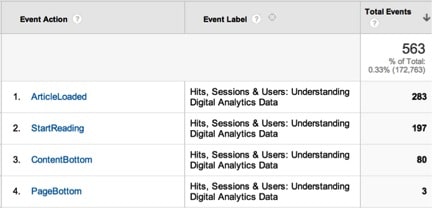Welcome back to our MozCon manifesto. This post continues our two-part series on content marketing takeaways from MozCon 2014, organized into a four-step process. Part 1 covered the conception and creation stages of content marketing, as well as the reasons to do it in the first place. In part 2, we’re covering promotion and measurement—two steps that many marketers neglect. Read on for tips on how to get your content in front of the right audiences as well as how to measure and report on your efforts.
Step 3: Promote
At the end of step 2, having completed the conception and creation processes, you delivered your masterpiece. It’s easy to sit back and breathe a sigh of relief once you’ve clicked the publish or upload button. But hold tight there, marketer. Your work is not done. An essential aspect of getting your content the attention it deserves is promoting it. Share it with your community. Amplify it to folks who would find it fascinating. Get it in front of journalists who can propagate it. Promote your content like you mean it. Remember, this should be easy if you’ve built something you’re proud of.
Paid organic amplification is something we’ve talked about for years. Any company that wants to build a community, brand itself to potential employees, customers or investors or actually sell stuff needs to undertake a well-targeted amplification program. Targeting bloggers and journalists with exceptional content can result in coverage, links and exposure to potentially huge audiences—audiences that could end up on your website.
Several presenters spoke to the value of this tactic, but determining who to actually pitch can be a challenge for those without media connections. Lexi Mills and Stacey MacNaught reminded marketers of tools that most are already familiar with. Use Google to conduct a site + topic search to quickly find targets that cover your beat, and limit your search results to the past week or month to find current contacts, Lexi recommended. Don’t forget about Facebook Graph Search, Stacey added. Try searches such as:
- Journalists who like [topic]
- Journalists who like [brand]
- Bloggers who like [brand]
Filter your results for a more focused list or deeper insights.

There are, of course, a number of other ways to build your media list. Regularly reading the publications you want to be featured in will help you get a sense of who covers what, and media database tools such as Vocus and Cision can aid in outlet discovery and contact information gathering.
Once you’ve built a list, you’re ready for outreach. You can go the tried and true route with traditional pitch emails and phone calls, or you can try the same paid amplification vehicles you’re using to build your community and reach new customers. Facebook ads are a great vehicle for supporting outreach, Paddy said. Try uploading a list of blogger and reporter emails and targeting via a Custom Audience. If that’s not feasible, target people who work at specific publications or have journalism-related job titles. Paddy recommended creating lookalike audience lists to expand your reach. Twitter tailored audiences are also worth testing, he said.
Step 4: Measure
OK, so I promoted my content. I’m done now, right? Wrong. There’s one last step. Remember those goals you set in step 0.5? It’s time to report on whether you met them. If you don’t, how will you know you were successful? How will you know what to change next time around? Setting goals and then measuring whether you met them is the only thing that proves your value, Dana DiTomaso said. The way we become indispensable is through goal-focused reporting. Just like promoting your content is simple if you’ve built something amazing, measurement is easy if you set SMART goals at the beginning.

Collect multiple data points with Google Analytics events to move beyond time on page, he recommended. When someone lands on your content, the first thing that happens is the page loads. Next, track if someone starts to scroll through the content. Track points along the way, such as end of content and bottom of page. This isn’t terribly difficult to do, and Justin provides instructions on implementing such tracking in Universal Analytics on his blog. This will result in GA data that looks like this (image from Justin’s post):
Pretty sweet, huh? Paddy Moogan had some additional advice. What’s more powerful, he asked: Telling your client you got 4 DA 85+ links, 4 links from [well known publications], or that you sent 1 million+ visitors to their site? Don’t let the results of your content promotion end at the links you obtained. Take it further and measure how many people your efforts sent to the site. Create custom segments for your outreach lists to demonstrate the value of those links.
So that, friends, is everything you missed (or wanted a refresher on) about content marketing at MozCon 2014. Now go forth and make something amazing.
TL;DR
Go back and read everything in bold. Feeling lazy? Here you go:
Why content marketing?
- Content done right can draw attention, rank well, amass links, drive traffic, generate awareness and interest, build preference, and ultimately increase sales
- Setting goals is an important part of planning your content marketing strategy
Step 1: Conceive
- Go big or go home
- Goals first, format second
- Build something amazing
- Become a subject matter expert
- Find a system that’s easy to repeat
- Determine who your audience is and what their interests are
- Use an efficient means of idea generation
- Narrow down the candidates
- Undertake a content competitor analysis
Step 2: Create
- Save the best ideas for first
- Determine the best format for conveying your idea
- Understand your audience, engage them emotionally and use psychological triggers
- Test everything as early as you can
- Accommodate your audience, no matter their location, device, or other limiting factors
- If you don’t love it, you can’t ship it
Step 3: Promote
- Share it with your community. Amplify it to folks who would find it fascinating. Get it in front of journalists who can propagate it.
Step 4: Measure
- Determine whether you met your goals
- Measure what matters
© indomercy – Fotolia










